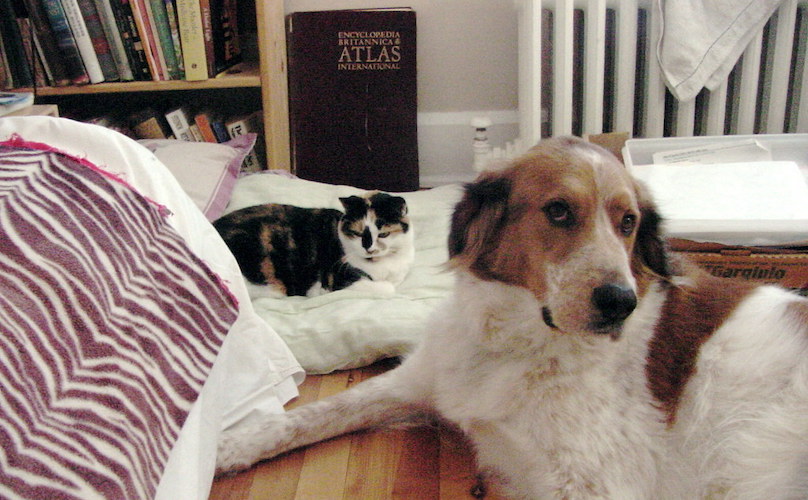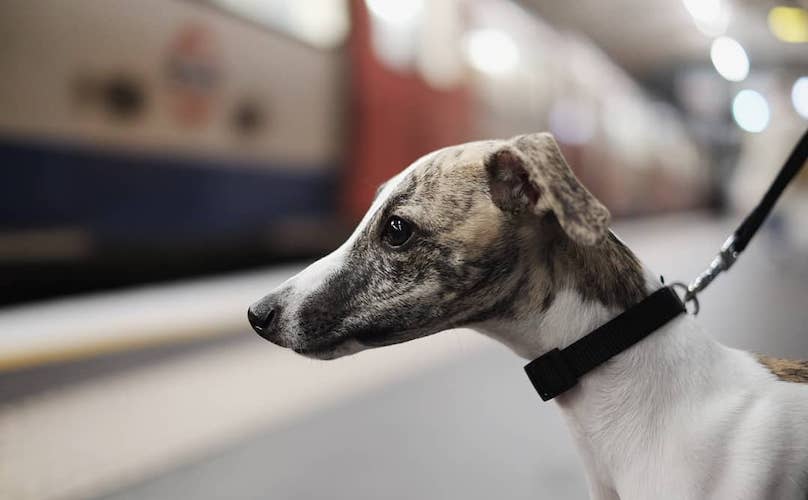***Looking for a gift for your new dog? Spoil them with a BarkBox! Every month BarkBox delivers 2 original toys, designed in-house, 2 full bags of all-natural treats, and a chew. Sign up here and receive a free extra toy every month. <– This deal is worth up to $120 in value if you sign up for a 12-month subscription! 🙂
How to appropriately introduce a new dog into a home with a cat is a frequently asked question for good reason. The rivalry between cats and dogs is a common stereotype. It’s assumed that these two species dislike—nay, hate—each other and thus are constantly at war. However, relationships between felines and canines can often be loving and strong (not to mention highly entertaining). How does one achieve this symbiotic relationship in their home though, especially if a new dog is being brought into the domestic territory of a cat?
As it turns out, a calm, controlled and informed introduction between a new dog and cat is key. If you’re bringing home a canine when you already have a resident feline, here are several tips and precautions to keep in mind:
Choose the Right Dog for You AND Your Cat


Even before the inevitable meetup between cat and dog, there are several factors to analyze. While everyone would love to have a cat and dog that snuggle and play together, this simply isn’t possible for each pair of animals Therefore, if adopting/acquiring an older puppy or grown dog, it’s important to consider their past experience, personality and reactions to cats.
Nowadays, animal shelters will usually list whether a dog is “cat friendly” or not. Often times they’ll test a dog’s reactions to cats by having it sniff or pass by a cage with a cat inside. If possible, they’ll also gather information from the previous owner on whether the dog had contact with cats and, if so, how the dog behaved. That said, whether you have background information about a particular dog’s experiences with cats or not, you should also evaluate your potential new dog’s demeanor.
For those playing “matchmaker” between dogs and cats, look for a calm, gentle and good-natured dog. An overexcited and jumpy dog could potentially get into some trouble around your cat unless you’re able to calm her down. Or, a dog that displays a strong prey drive during a test walk may view your feline friend as something to chase. (Or, worse, as supper.)
As well, evaluate your own cat’s behavior. Is he calm, confident and playful? Does he adjust to new situations quickly? Or does he hiss, growl, swat or run and hide in response to a dog sighting? If your cat doesn’t seem to enjoy the presence of new animals, take a moment to consider your decision to get a dog at all. If one or both of your animals will be miserable in each other’s presences, it’s likely best not to bring a new dog into your home.
Planning Ahead


First off, taking the stance of “let’s just see what happens” is never a good idea when introducing new animals together, regardless of species. In order to get off to a good start, make sure to have a game plan. For the protection of your cat (or to protect a puppy or small dog from a potentially angry cat), it’s best to keep both parties separated at first. Allow your new dog to sniff and adjust to her new home environment without the extra stress of a hissing or growling cat.
You should also plan for baby gates, crates and/or leashes to be involved in the meeting process. Instead of letting both dog and cat free roam in the house, which could potentially lead to a chase or fight, control the environment. Letting a new dog sniff a cat who is confined in a room or cage will help you gauge the reactions of both animals. Or, keep your new dog on leash while meeting the kitty. Just remember not to apply tension to the leash, as well as to take charge if you feel that your cat is in any danger.
If you need to leave the house, remember to never leave your new roommates alone together. Separating them into two different rooms or kenneling your new dog is vital to preventing any conflict.
Watch for Warning Signs


Even if your new dog and cat seem to be coexisting relatively peacefully, it’s still vital to monitor their behavior for signs of conflict during those preliminary weeks. Here are some warning signs that there’s trouble in paradise, and some suggestions for how to deal with them:
- If your cat continues to growl, hiss, swat or raise his hackles at your new dog, then he’s likely very stressed out. Thus, it’s important to create a sanctuary space for your cat. Having a dog-free zone to retreat to will allow your cat to relax and take a breather from his new housemate. Although you can continually keep a “cats only” room in your house, the goal should be to have all your animals coexisting peacefully. Thus, continue expanding the number of hours a day that all of your animals are together.
- If your cat not only displays “I don’t like you” behaviors towards your dog, but also shows further signs of stress, more intervention may be needed. Unhappy cats will sometimes stop eating, drinking, socializing or using the litter box. A cat who is urinating or defecating on the floor in response to the presence of a new dog is particularly at risk for suffering from stress. In that case, it’s best to speak with your vet or an animal behavioralist. Having a dog may be unfair to your cat. In this case, tough but responsible decisions will need to be made.
- If your new dog focuses on your cat with an obsessive gaze, your cat could be in danger. Furthermore, if your dog seems to be holding herself back from lunging, attacking or chasing, this match is likely not a good one. At some point, fixating and/or stalking could turn into action. In this case, the focus should be on how to protect your cat while evaluating and making decisions about your new dog’s behavior.
- If your new dog regularly lunges at, chases, tries to catch, growls or snaps at your cat, this is absolutely not a safe match. Again, the situation will likely not resolve itself on its own. Thus, tough decisions need to be made in order to keep both animals safe and happy.
- Don’t be afraid to get a trainer! That’s what they’re there for.


In the wonderful case that your new dog and cat are getting along well, you can eventually introduce unsupervised time between the two. That said, this scenario should only happen once you’re confident that neither animal is at risk of scaring or hurting the other. Hopefully, with time, you’ll foster and play witness to a heartwarming feline-canine friendship.
Featured image via Unsplash
Looking For More Articles Like This?
What Is The Best Way To Train My Dog To Listen To Me?
How Do I Train My Dog To Come To Me?
Clicker Training 101: How Do I Use It To Communicate With My Dog?






